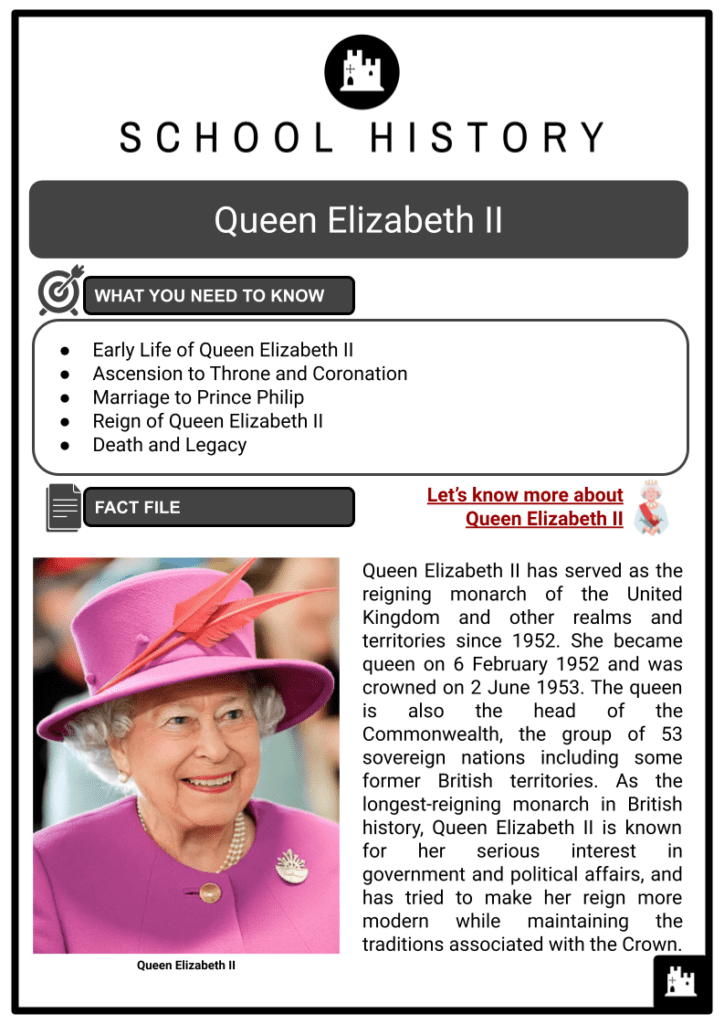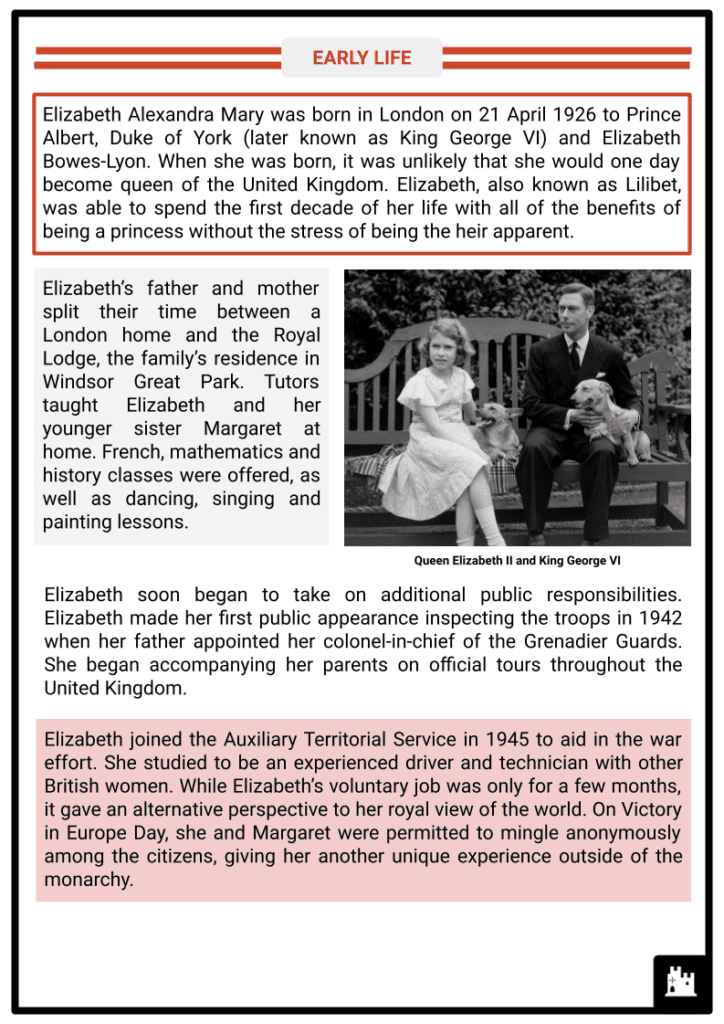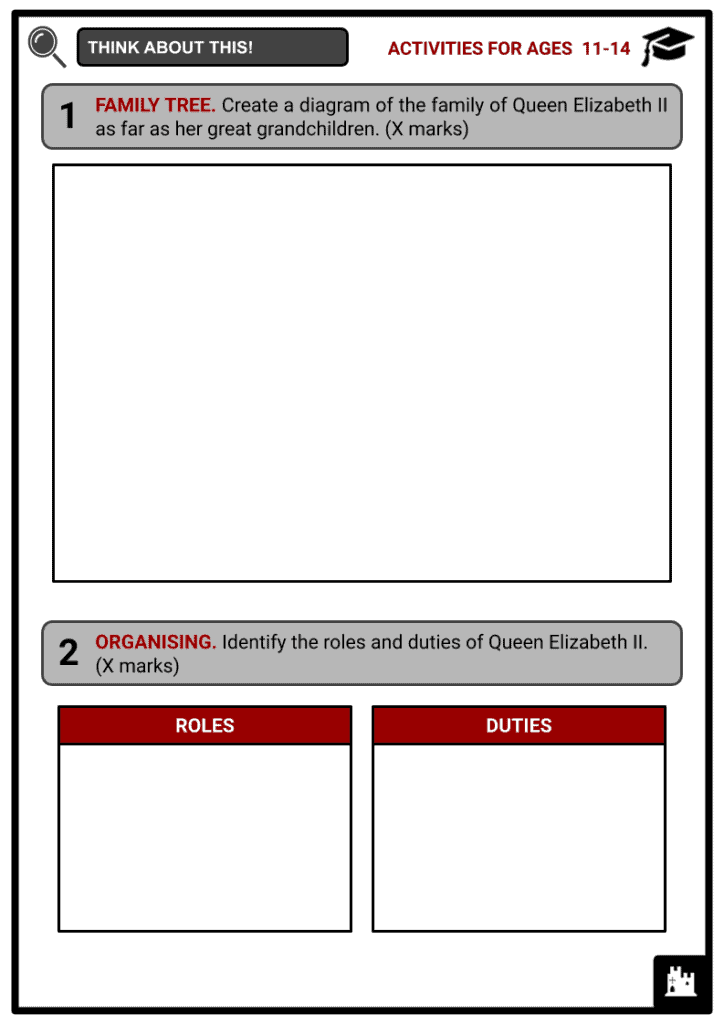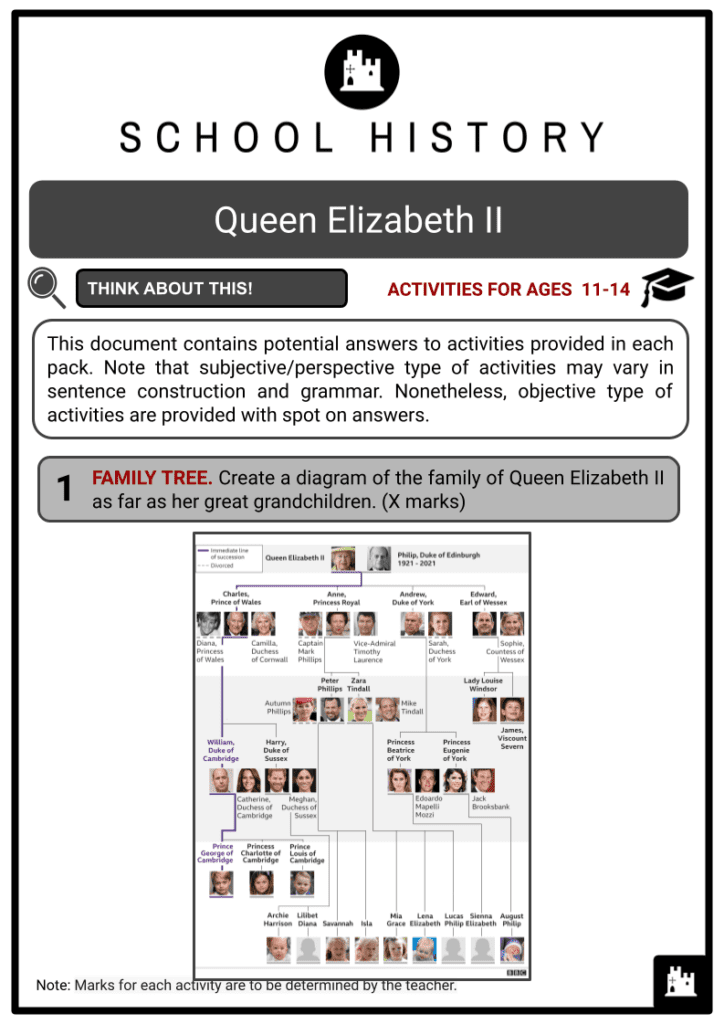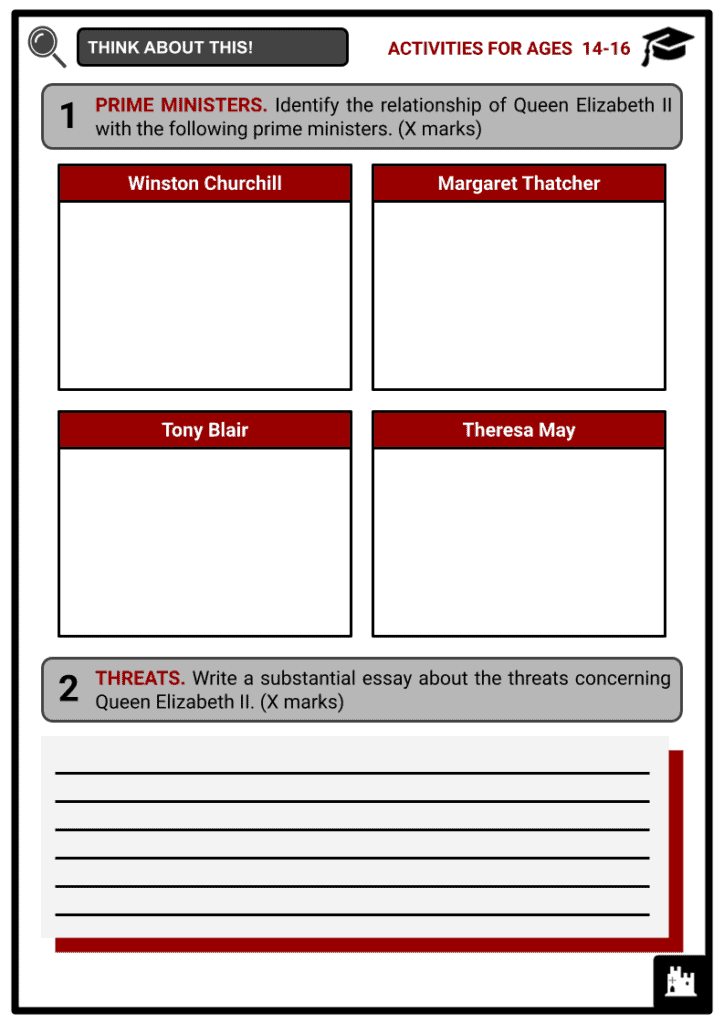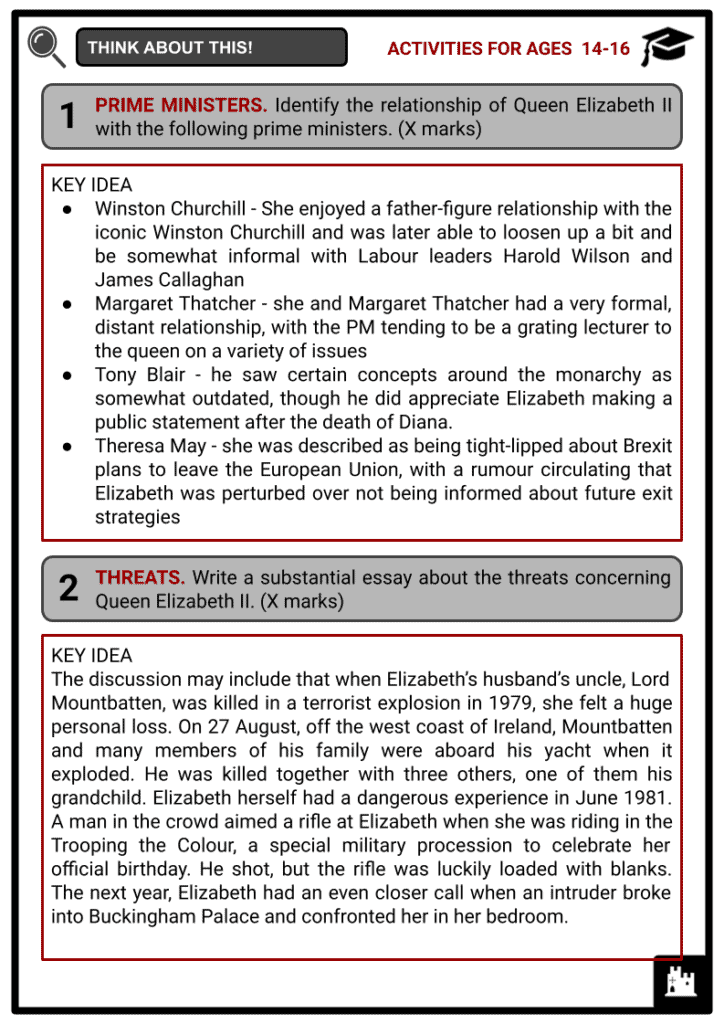Download Queen Elizabeth II
Do you want to save dozens of hours in time? Get your evenings and weekends back? Be able to teach about Queen Elizabeth II to your students?
Our worksheet bundle includes a fact file and printable worksheets and student activities. Perfect for both the classroom and homeschooling!
Table of Contents
Add a header to begin generating the table of contents
Summary
- Early Life of Queen Elizabeth II
- Ascension to Throne and Coronation
- Marriage to Prince Philip
- Reign of Queen Elizabeth II
- Death and Legacy
Key Facts And Information
Let’s find out more about Queen Elizabeth II!
- Queen Elizabeth II has served as the reigning monarch of the United Kingdom and other realms and territories since 1952. She became queen on 6 February 1952 and was crowned on 2 June 1953. The queen is also the head of the Commonwealth, the group of 53 sovereign nations including some former British territories. As the longest-reigning monarch in British history, Queen Elizabeth II is known for her serious interest in government and political affairs, and has tried to make her reign more modern while maintaining the traditions associated with the Crown.
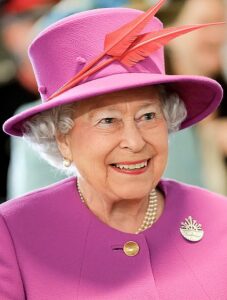
Early Life
- Elizabeth Alexandra Mary was born in London on 21 April 1926 to Prince Albert, Duke of York (later known as King George VI) and Elizabeth Bowes-Lyon. When she was born, it was unlikely that she would one day become queen of the United Kingdom. Elizabeth, also known as Lilibet, was able to spend the first decade of her life with all of the benefits of being a princess without the stress of being the heir apparent.
- Elizabeth’s father and mother split their time between a London home and the Royal Lodge, the family’s residence in Windsor Great Park. Tutors taught Elizabeth and her younger sister Margaret at home. French, mathematics and history classes were offered, as well as dancing, singing and painting lessons.
- Elizabeth soon began to take on additional public responsibilities. Elizabeth made her first public appearance inspecting the troops in 1942 when her father appointed her colonel-in-chief of the Grenadier Guards. She began accompanying her parents on official tours throughout the United Kingdom.
- Elizabeth joined the Auxiliary Territorial Service in 1945 to aid in the war effort. She studied to be an experienced driver and technician with other British women. While Elizabeth’s voluntary job was only for a few months, it gave an alternative perspective to her royal view of the world. On Victory in Europe Day, she and Margaret were permitted to mingle anonymously among the citizens, giving her another unique experience outside of the monarchy.
Ascention to Throne and Coronation
- At the age of 27, Elizabeth was crowned Queen Elizabeth II in Westminster Abbey on 2 June 1953. When her father, King George VI, died on 6 February 1952, Elizabeth took over the reign of the monarchy. The coronation ceremony was aired live on television for the first time, allowing people all around the world to watch the pomp and grandeur.
- When Elizabeth’s grandfather George V died in 1936, his eldest son (Elizabeth’s uncle) succeeded him as King Edward VIII, but Edward fell in love with American divorcee Wallis Simpson and had to choose between the monarchy and his heart. In the end, Edward abdicated the throne in favour of Simpson.
- The event changed Elizabeth’s life forever, making her the potential heir to the British throne. In 1937, her father was crowned King George VI, using the name George to maintain a sense of continuity with his father. Her mother was given the title of Queen Elizabeth, and after King George died in 1952, this became Queen Mother. Her daughter was given the title of Queen Elizabeth II.
- On 2 June 1953, at the age of 27, Elizabeth was crowned Queen Elizabeth II in Westminster Abbey. When Elizabeth’s father, King George VI, died on 6 February 1952, she inherited the throne. For the first time, the coronation event was broadcast live on television, allowing people all around the world to witness the pomp and ceremony.
Marriage to Prince Philip
- Elizabeth’s engagement to Prince Philip of Greece, her third cousin and a lieutenant in the Royal Navy, was announced in 1947, shortly after the royal family returned from an official visit to South Africa and Rhodesia. She had set her sights on him when she was just 13 years old, and their connection grew during the war through visits and writing.
- Great Britain was still recovering from the scars of World War II at the time of their wedding, and Elizabeth used clothes coupons to buy fabric for her gown.
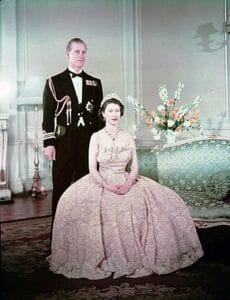
- Despite the fact that many in the royal circle thought Philip was an unsuitable match due to his lack of wealth and foreign (German) heritage, Elizabeth was determined and deeply in love with him. On 20 November 1947, she married Philip at Westminster Abbey.
- It didn’t take Elizabeth and Philip long to have a child: their son Charles was born a year after their wedding, and their daughter Anne was born in 1950. Andrew and Edward, Elizabeth’s two other sons, were born in 1960 and 1964, respectively.
- She designated Charles her formal successor by bestowing the title of Prince of Wales on him in 1969. The event was broadcast live to hundreds of millions of people across the world. Charles married Diana Spencer (better known as Princess Diana) in 1981, when he was 32 years old. Later, reports surfaced that he was forced into the marriage by his family. The wedding brought huge crowds to London’s streets, and millions tuned in to watch the ceremony on television. During this period, public opinion of the monarchy was very high.
Reign
- Elizabeth’s long and mostly peaceful reign has seen significant changes in the lives of her people, in the strength of her country, in how Britain is perceived abroad, and in how the monarchy is regarded and depicted. Elizabeth does not comment on political issues or expose her political beliefs as a constitutional monarch.
- After WWII, Britain still possessed a large empire, dominions and dependents when Elizabeth became queen. However, several of these territories gained independence throughout the 1950s and 1960s, and the British Empire became the Commonwealth of Nations. As the Ruler of the Commonwealth and a representative of the United Kingdom, Elizabeth II has visited a number of nations, including a groundbreaking trip to Germany in 1965. She was the first British monarch to pay a state visit to the country in almost 50 years.
- Elizabeth continued to travel widely in the 1970s and 1980s. She attended the Commonwealth Conference in Ottawa, Canada, in 1973, and the 200th anniversary commemoration of America’s independence from Britain in 1976 in the United States.
- She was in Montreal, Canada, to start the Summer Olympics less than a week later. She travelled to Kuwait, Bahrain, Saudi Arabia, Qatar, the United Arab Emirates and Oman in 1979, gaining worldwide recognition and respect.
- In 1982, Elizabeth was concerned about her second son Prince Andrew, who fought in the British Royal Navy as a helicopter pilot during the Falklands War. Argentina and the United Kingdom were at war for many weeks. Despite the fact that more than 250 British soldiers died in the conflict, Prince Andrew came home safely, much to the relief of his mother.
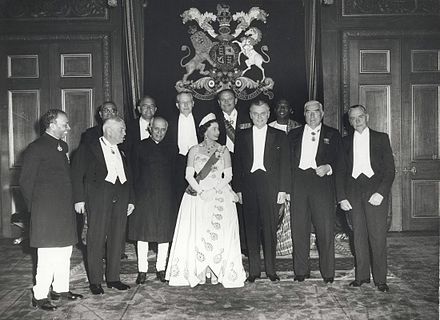
- During her reign, Queen Elizabeth faced several threats. In 1981, weeks before the wedding of Prince Charles and Lady Diana, 17-year-old Marcus Sarjeant fired six shots at Elizabeth as she passed The Mall in London. Despite discovering that the shots were blank, Sarjeant was sentenced to five years in prison but was released after three. By October, she was attacked again in a parade in Dunedin, New Zealand. The assailant Christopher John Lewis missed the shot and was arrested for attempted murder and treason.
- In 1986, Queen Elizabeth became the first British monarch to visit the People's Republic of China (PRC). She visited the Great Wall of China, the Terracotta Warriors, and the Forbidden City. The official visit signified the recognition of both countries to the sovereignty of Hong Kong, which was transferred in 1997.
- In the 1990s, Queen Elizabeth and the royal family were scrutinised as issues and scandals arose among its members. In May 1992, Prince Andrew separated from his wife, Sarah, at the height of marital affairs. By April, Princess Anne divorced Captain Mark Phillips.
- In the same year, Prime Minister John Major announced a reform of royal finances, one of which was Queen Elizabeth's payment of income tax from 1993 onwards.
- Probably the most significant blow of the year was the separation of Prince Charles and Princess Diana in December. In the years that followed, revelations about their marriage continued to reach the public.
- As a result, Queen Elizabeth suggested they divorce in 1995. A year later, Princess Diana was killed in a car crash in Paris, France. For five days, Queen Elizabeth kept Diana's sons, Princes William and Harry, away from the public. The royal family stayed at Balmoral while their seclusion and silence caused public dismay. Pressured by the public reaction, the royal family returned to London, and the Queen addressed the nation via live television broadcast on 5 September.
- In 1999, Queen Elizabeth led the formal opening of legislatures in Cardiff, Wales and Edinburgh, Scotland.
- For the second time, Elizabeth II, Queen of all Commonwealth realms, addressed the UN General Assembly in 2010.
- During her Diamond Jubilee in 2012, Queen Elizabeth and Prince Philip toured the United Kingdom, while other members of the royal family embarked on royal tours in Commonwealth states. In the same year, the royal couple also celebrated their blue sapphire wedding anniversary (65th). In 2017, as they celebrated their platinum wedding anniversary, Prince Philip retired from his duty as the Queen's consort.
- When, in 2011, Elizabeth became the first British monarch to visit the Republic of Ireland since 1911 (when all of Ireland was still part of the United Kingdom), she demonstrated that the monarchy still has symbolic and diplomatic significance.
- As queen, Elizabeth has modernised the monarchy, reducing some of the monarchy’s formalities and allowing easier public access to various sites and treasures. As Britain and other countries suffered financially, the Civil List, a royal family public financing scheme dating back nearly 250 years, was disbanded in 2012. Although the royal family continues to receive government assistance, the queen has been forced to reduce her spending.
- As she approached her 90th birthday, Elizabeth remained faithful in her royal duty, despite periodic calls to step aside for Charles. She continued to make about 400 appearances every year, and she continued to assist hundreds of charitable groups.
- However, in late 2017, the monarch made a significant step towards passing it on to the next generation: on 12 November, Charles took charge of the customary Remembrance Sunday duty of laying a wreath at the Cenotaph war memorial, while the queen observed from a nearby balcony.
- Elizabeth made a rare step into politics in August 2019, agreeing to Prime Minister Boris Johnson’s request to prorogue (halt) Parliament until 14 October, less than three weeks before the UK’s planned departure from the European Union.
- When the CoViD-19 pandemic hit the UK, Queen Elizabeth moved to Windsor Castle. Under HMS Bubble, all public engagements were cancelled to protect her health. To comfort the British public, she had a televised broadcast on 5 April 2020, ensuring that better days would return. In January and April 2021, the Queen received her CoViD-19 vaccinations.
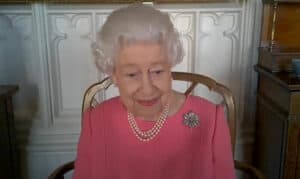
Queen Elizabeth II making a video call for the deployment of COVID-19 vaccine - On 9 April 2021, Elizabeth II shared the fate of Queen Victoria and reigned as a widower. Prince Philip died. Due to the pandemic, Prince Philip's funeral service became private. Queen Elizabeth's image while sitting alone at her husband's funeral evoked sympathy worldwide. In the same year, Queen Elizabeth attended the opening of the Parliament and the G7 Summit.
Death and Legacy
- Queen Elizabeth II celebrated her Silver Jubilee in 1977, Ruby Jubilee in 1992, Golden Jubilee in 2002, Diamond Jubilee in 2012, Sapphire Jubilee in 2017, and Platinum Jubilee in 2022.
- On 9 September 2015, Queen Elizabeth II became the longest-lived and longest-reigning British monarch and longest-serving female head of state, surpassing her great-great-grandmother, Queen Victoria.
- On 8 September 2022, two hours after the announcement of Buckingham Palace about Queen Elizabeth's medical supervision, she died, age 96, at Balmoral Castle, surrounded by her children and grandsons, Princes William and Harry. Under Operation London Bridge, the Queen's state funeral was set. On 19 September, her state funeral was held at Westminster Abbey. While billions of people watch the news, millions stand in line at the abbey. Her body was interred at King George VI Memorial Chapel, St. George's Chapel, along with her husband, sister and parents.
- Throughout her reign, Elizabeth II had 15 British Prime Ministers, including Winston Churchill, Anthony Eden, Harold Macmillan, Alec Douglas-Home, Harold Wilson, Edward Heath, James Callaghan, Margaret Thatcher, John Major, Tony Blair, Gordon Brown, David Cameron, Theresa May, Boris Johnson, and Liz Truss.
- Moreover, she met 13 US Presidents, from Harry S. Truman up to Joe Biden. At the time of her death, the Commonwealth realms had 15 states. Queen Elizabeth's appointment of Liz Truss as prime minister was held at Balmoral Castle, the only charge made by the Queen outside Buckingham Palace.
- Elizabeth II was succeeded by 73-year-old Charles III (Prince Charles), who became the oldest person to assume the throne, and the longest-serving heir apparent.
Image sources
- https://upload.wikimedia.org/wikipedia/commons/thumb/b/b6/Queen_Elizabeth_II_in_March_2015.jpg/440px-Queen_Elizabeth_II_in_March_2015.jpg
- https://upload.wikimedia.org/wikipedia/commons/thumb/e/ed/Elizabeth_II_and_Philip.jpg/340px-Elizabeth_II_and_Philip.jpg
- https://upload.wikimedia.org/wikipedia/commons/thumb/2/21/Queen_Elizabeth_II_and_the_Prime_Ministers_of_the_Commonwealth_Nations%2C_at_Windsor_Castle_%281960_Commonwealth_Prime_Minister%27s_Conference%29.jpg/440px-Queen_Elizabeth_II_and_the_Prime_Ministers_of_the_Commonwealth_Nations%2C_at_Windsor_Castle_%281960_Commonwealth_Prime_Minister%27s_Conference%29.jpg
- https://www.newmyroyals.com/2021/02/queen-elizabeth-ii-made-video-call-to.html

